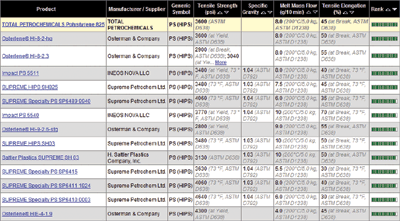Materials Specifier: Offset with care
Whatever the reason for seeking alternative materials, the bottom line is that they must perform adequately in real-world conditions.
July 1, 2008
Whatever the reason for seeking alternative materials, the bottom line is that they must perform adequately in real-world conditions.
|
One of the most common questions IDES receives from designers is, “What is the most suitable offset for a material I’m using now?” In response, IDES developed a module in its Prospector online materials database that helps a customer find the best match with a single mouse click. It’s called Alternative Resins Search, and from January-May 2008, this function had been used 10,409 times.
Application: Housing for a consumer-market small appliance.
Goal: Find a suitable replacement for high-impact polystyrene (HIPS) from current supplier.
Criteria and most important properties:
• Properties as similar to original grade as possible
• Injection molding grade only
• North American commercial availability
IDES search notes:
The particular grade of HIPS being used was 825, so the first step was to locate that material in Prospector, using the Quick Search. IDES searched for “825” and narrowed it down to three grades.
Viewing a few data sheets to locate the exact material the customer was currently using was followed by a single click on the alternatives icon in Prospector. This set up an alternatives search that compares the target grade to all 74,000 materials in the database. Immediately, the search was narrowed to 735 materials identified as unfilled HIPS. In addition to narrowing the field, after the alternatives algorithm compares the data on each material to the current grade, it then provides a ranked list of products based on the property data.
|
IDES found many materials that closely matched this product, but decided to narrow the search a bit further using the Results Filter. The search was narrowed to materials commercially available in North America that have been specified as suitable for injection molding. This ensured that no time was wasted looking at materials that the customer couldn’t purchase in the U.S. It also limited the search results to 172 products.
Normally, this is still a very large set of products to look through, but with the Ranking Bar and the ability to look at property data in the results table, it was relatively easy to scan the list and find a few materials that could be suitable alternatives. With these tools, the customer chose four products to compare against the current grade.
After viewing the comparison, the customer used the sourcing feature to contact suppliers and distributors who could provide more information about these grades.
Commentary by consultant Jack Avery:
|
In today’s environment, many requests for offset materials result from attempts to find lower-cost sources or multiple sources. For this purpose, the Alternative Resins search in IDES Prospector is a valuable tool to identify potential alternatives.
However, it is important to be aware of the fact that an exact or “close” material property match may not meet the application’s end-use requirements. Whoever is the material specifier for a product (OEM, contract manufacturer, processor, etc.) must guarantee that the material is suitable for its intended purpose. This guarantee usually results from extensive application testing at exaggerated end-use conditions. In order to make the guarantee, buyers typically rely on testing results from suppliers data sheets, so using the IDES Sourcing feature to identify and follow up with suppliers is a critical step in the process.
Remember, though, that one issue with data sheet properties is that they result from controlled testing, while the application in its end-use environment does not. ASTM and ISO test samples do not reflect part design, and are molded under different conditions. They do not account for weldlines and flow directions. In addition, strain rates, usage temperatures, and conditions are different.
Compositions can also be different. Stabilizers, additives, and pigments can alter performance. When considering use of offset materials, it is important to work closely with the material supplier to validate the product end-use performance using the offset material.
Another significant factor may be regulatory requirements. For example, in the medical device market, devices utilize FDA-approved materials. Changing from one resin to another based on equivalent properties is not an option under ISO 10993 and USP ClassVI. Trace contaminants and other aspects that have been qualified for one resin may not be equivalent in another. This may also be applicable if the product will be exported to a number of countries, as it must meet applicable requirements of the target countries.
Identifying and using offset materials can be valuable and sometimes essential. However, it is critical to do a thorough assessment of their viability based on real-world, end-use performance.
Contact information: |
About the Author(s)
You May Also Like





